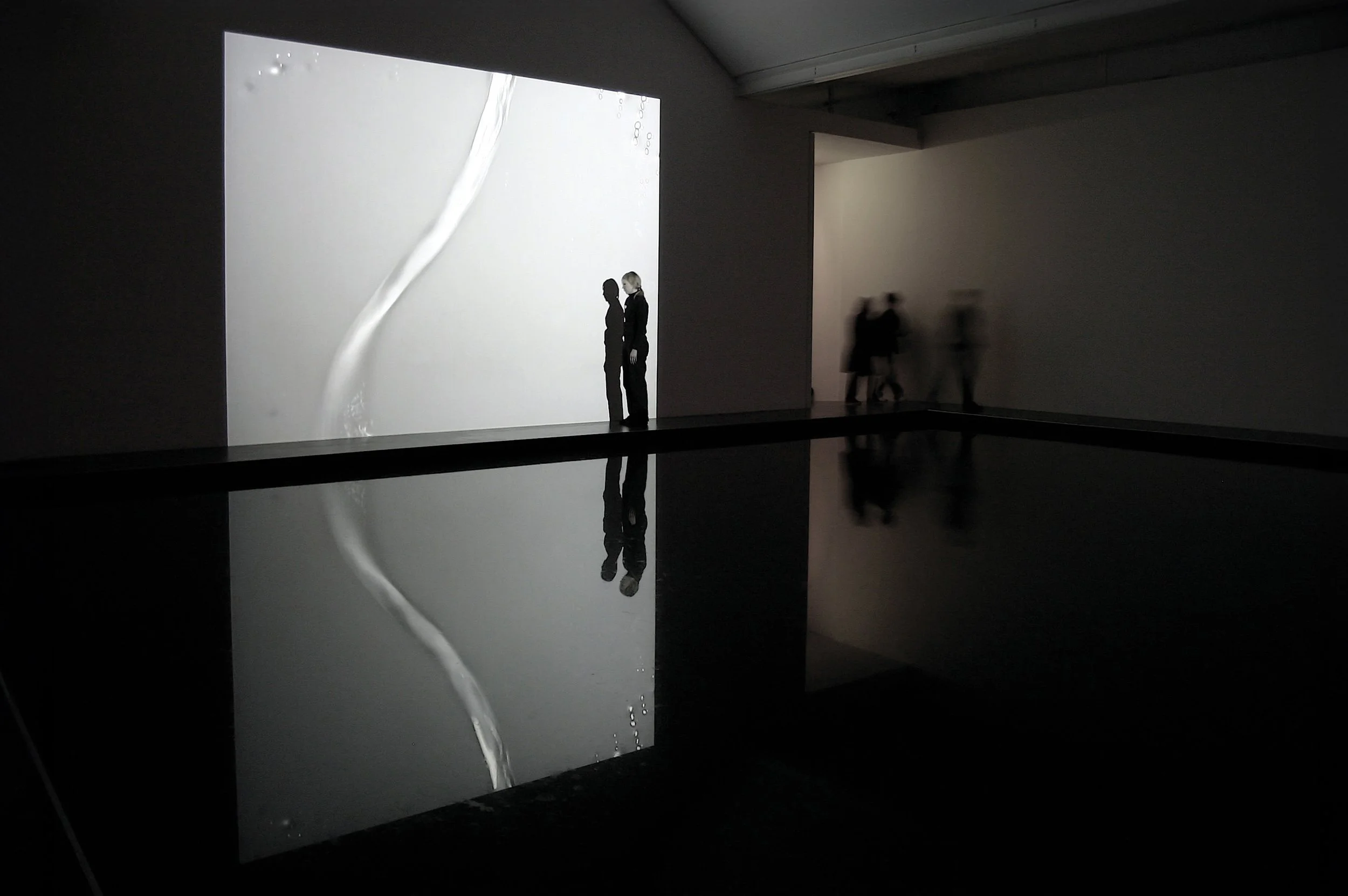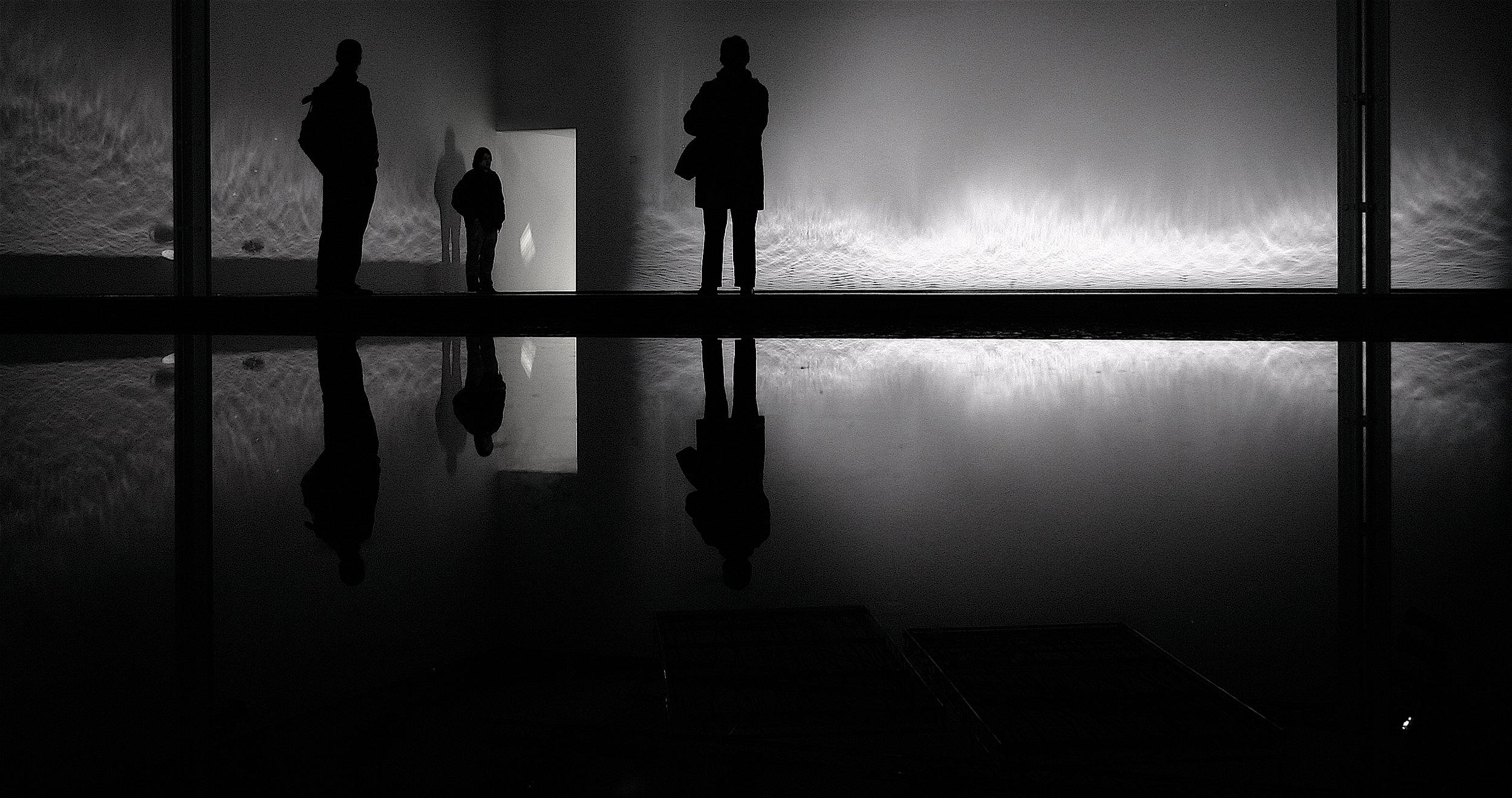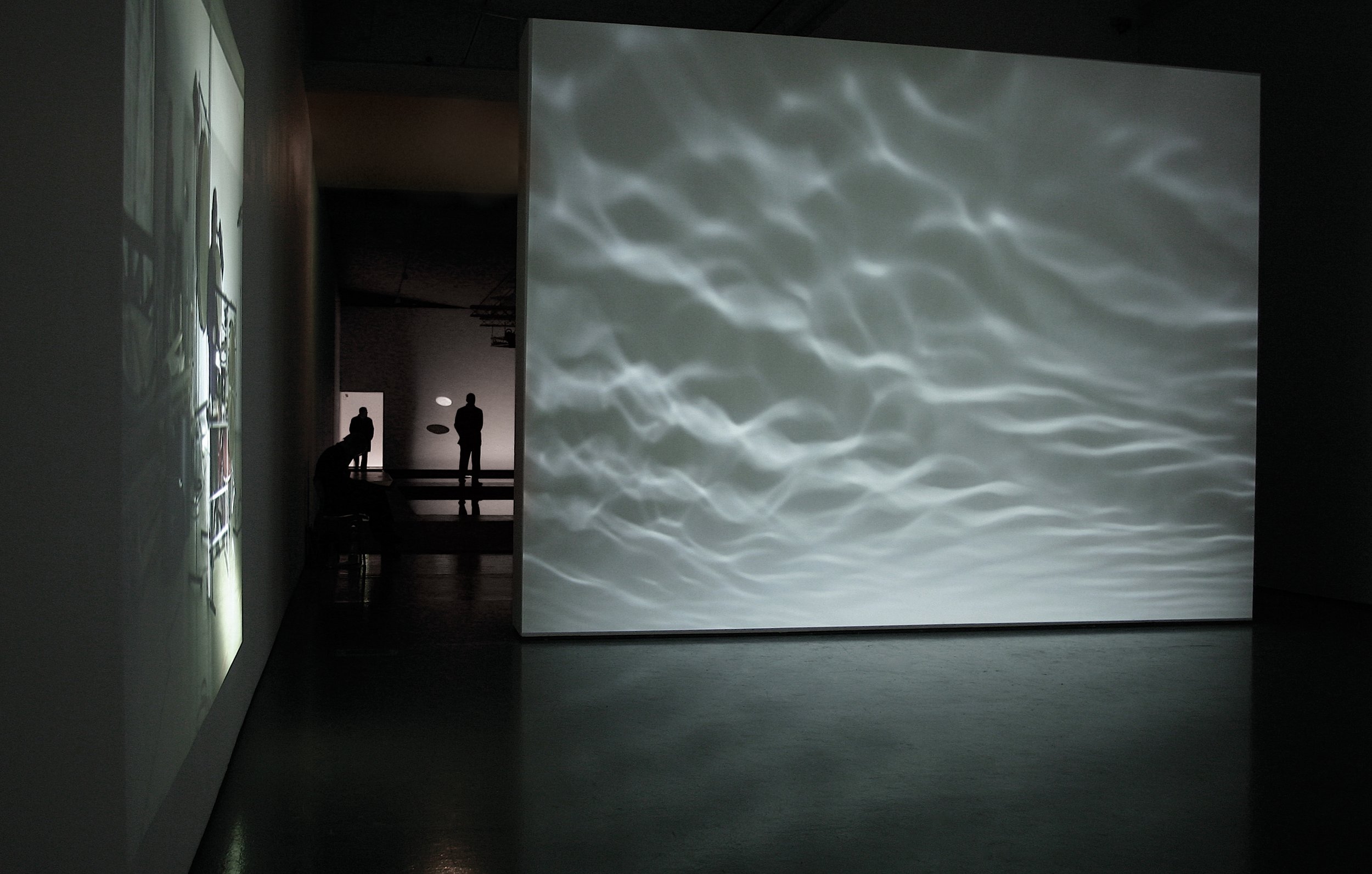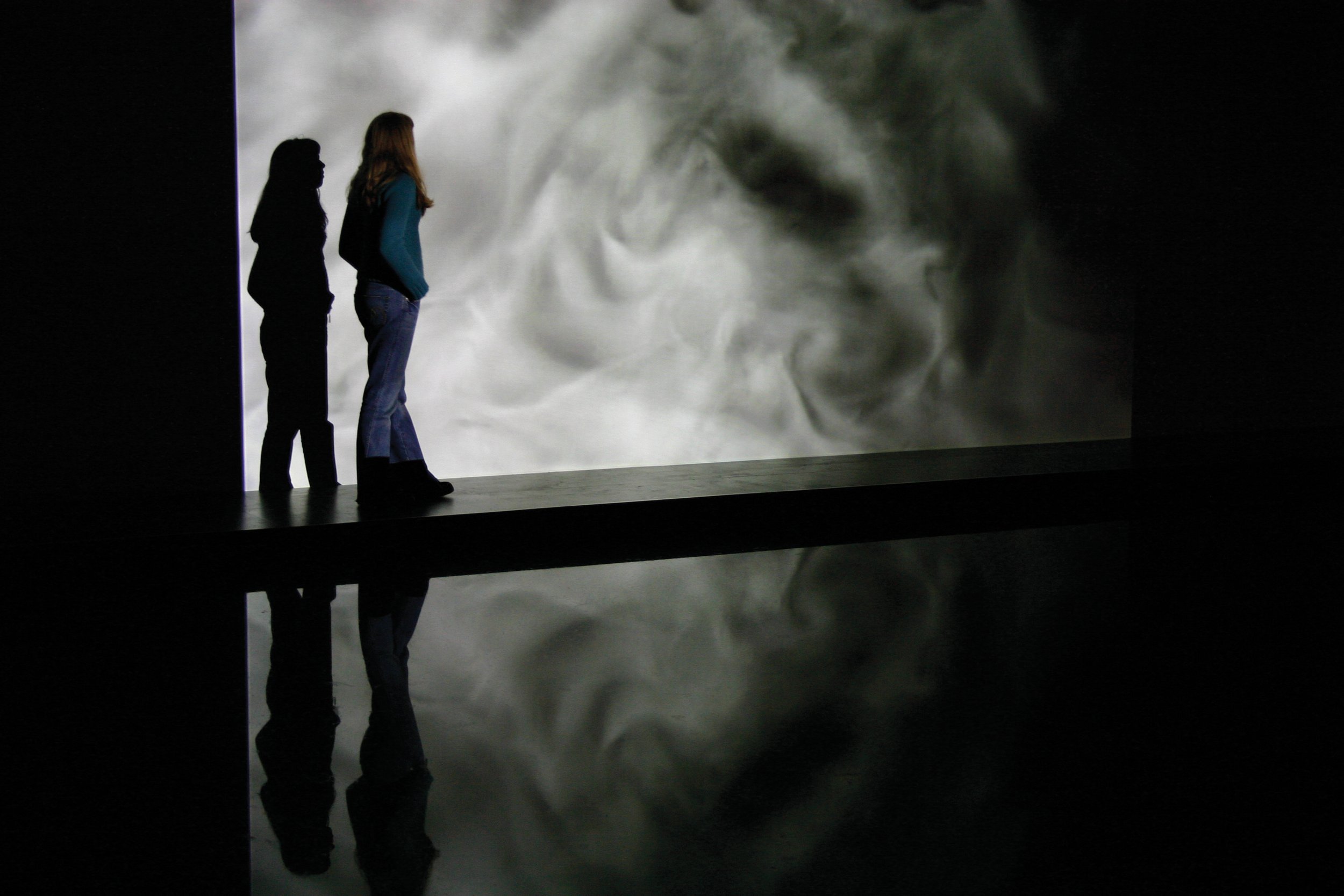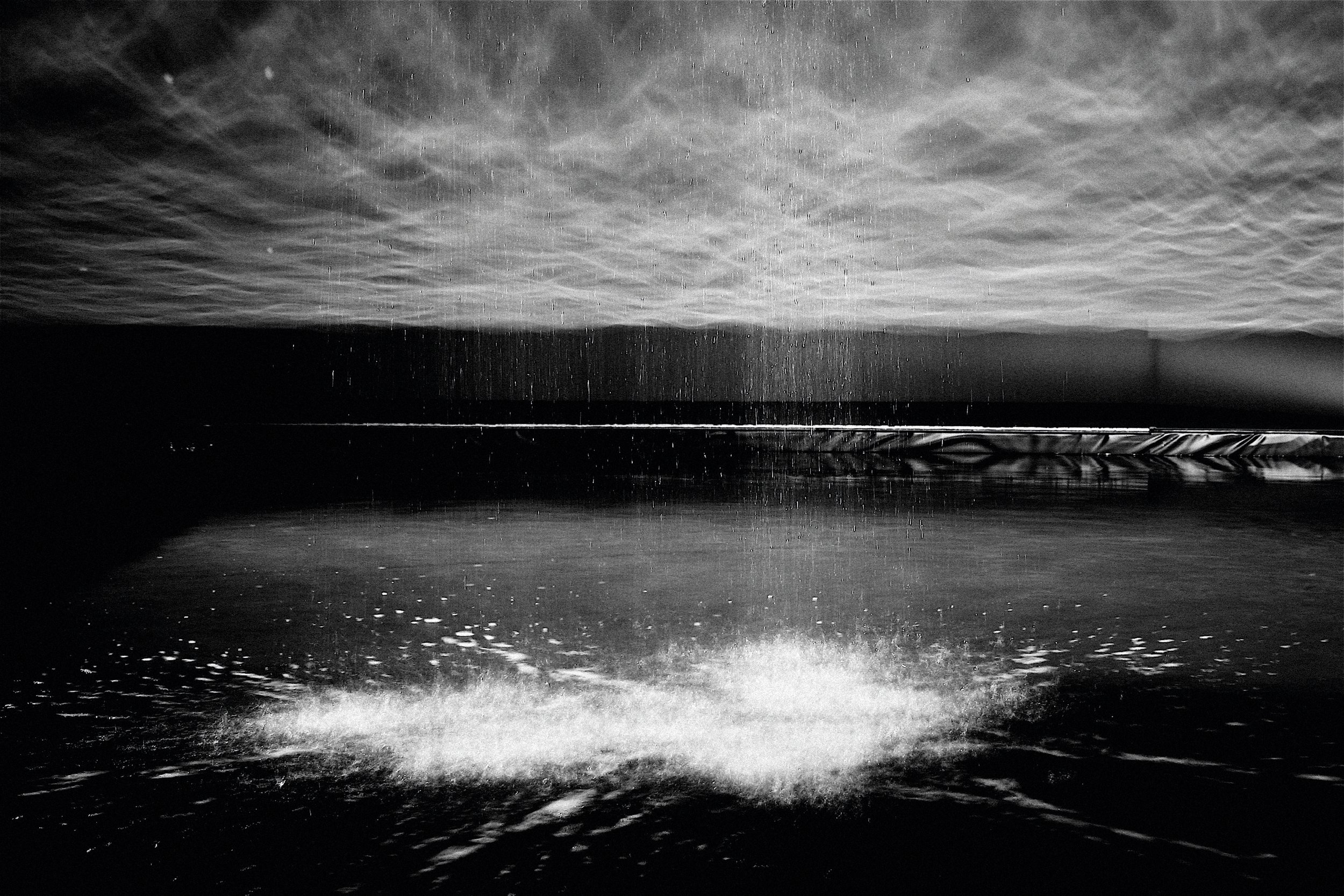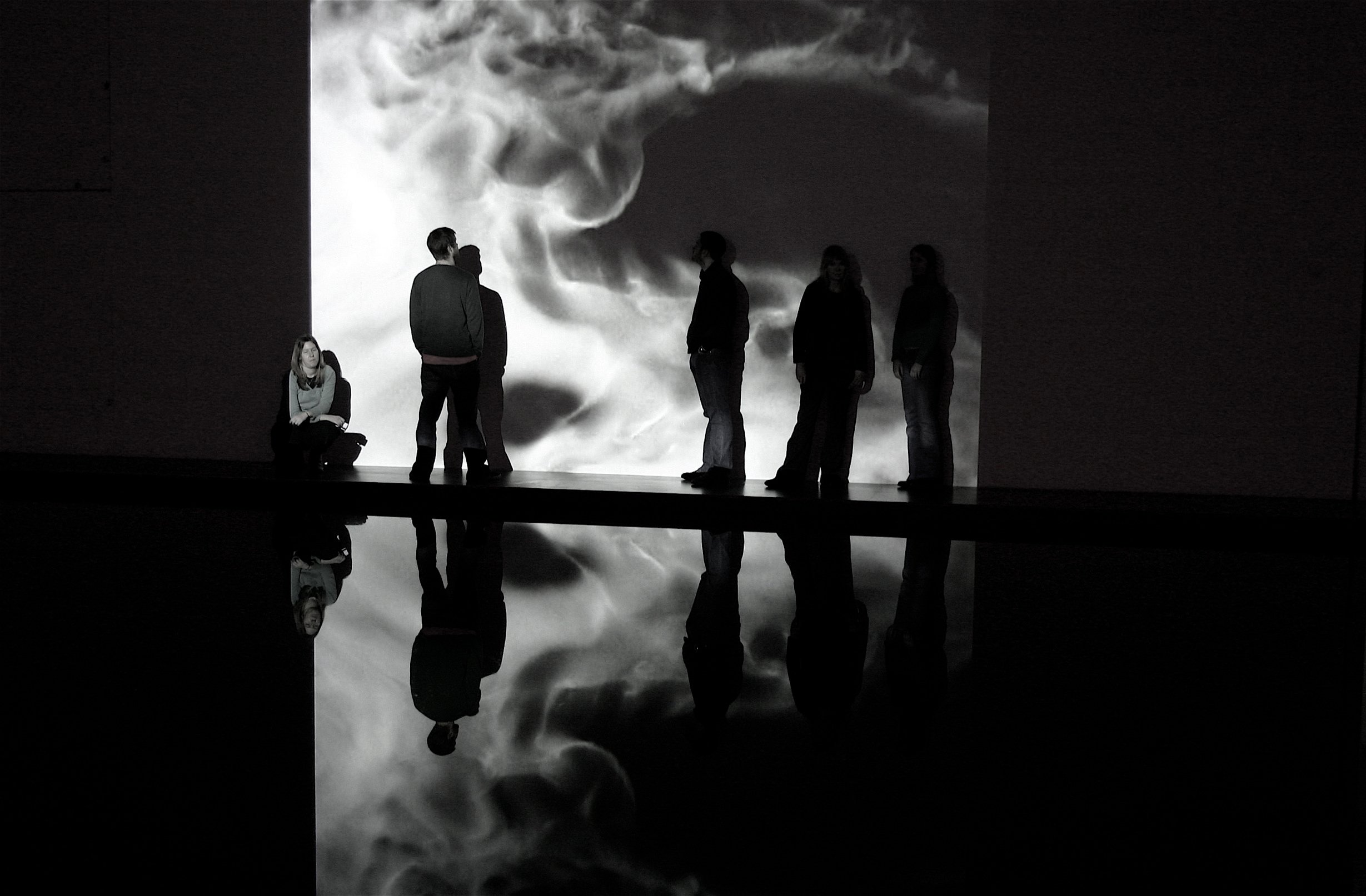In her stunning transformation of DCA’s galleries, Ogilvie invited us to explore and reflect on water, via live and recorded events. In an ambitious and technically challenging installation, DCA’s large main gallery was darkened and converted into two large pools, surrounded and connected by simple, walkable paths. One remained still, the other was animated by various mechanisms, creating live light drawings on the wall through physics principles.
“Ogilvie is one of the most significant artists of her generation in Scotland”, Dundee Contemporary Arts states. “With a compelling vision and strong track record in realising projects of scale and critical public engagement. The success of Bodies of Water lies with Ogilvie’s commitment to her audience enabling them to interact with, experience/explore one of our most precious natural resources. Through series of installations viewer is offered opportunity to share in Ogilvie’s experience of sensorial engagement within environment. The effect of the work is then to affect.”
Water has recently and increasingly been described as the oil of the twenty-first century. It is a powerful analogy, as it not only acknowledges the fundamental necessity of the substance to civilised life, its scarcity as a natural resource and the politics of ownership and control. It also evokes the prospect of conflict, for oil has been the source of so much of the crises of recent history. The suggestion that something we habitually consume, utilise and regard with little or no thought, that this substance we take so much for granted – particularly [here] in Scotland where we live literally surrounded by it – will become a serious source of contention, even violence, is undoubtedly challenging.
It is therefore a timely moment for the work of Elizabeth Ogilvie, an artist who has so often drawn inspiration from various ‘bodies of water’, the title of her major exhibition of new work at Dundee Contemporary Arts in 2005. Living and working by the sea for much of her life, Ogilvie has long fostered an appreciation of its power, both physical and emotional. Her art does not seek to promote the fast emerging politics of water, but operates at a more essential level to encourage us to consider its worth: to marvel at its visual and physical effect, to appreciate its universal and sustaining properties. Moving on from two-dimensional and sculptural works in recent years to vast installations and environments, Ogilvie increasingly offers us experiences rather than images. Her work has turned to look at the uses or applications of water in architecture, in the creation of spaces – often conceived quite literally for reflection, both physical and mental.
In her stunning and dramatic transformation of DCA’s galleries, Ogilvie invited us to explore and reflect on water, the most fundamental of substances. She looked at patterns of change, movement and transformation in subtle and delicate plays between light and darkness, in both live and recorded ‘events’. In an ambitious and technically challenging installation, DCA’s large main gallery was darkened and converted into two large pools, surrounded and connected by simple, walk-able paths. One remained still and utterly mirror-like, while the other was regularly animated by various mechanisms, effectively creating live drawings with light in the space of the viewer’s encounter. Abstract patterns and striking monochrome effects were created by water in its various states of movement.
Ogilvie’s work involves elements of art, architecture, science and music, the smaller gallery being occupied by a three-screen video installation made in collaboration with Joji Hirota, a ‘Taiko’ drummer and internationally renowned composer and performer. This documented an interplay between sound and light, between Hirota’s performance and Ogilvie’s parallel manipulation of a small pool of water. Together the installations evoked something of the wonder of natural phenomena, environmental concerns and the complexity of what can appear so simple. Dundee’s renowned river setting, with the Tay flowing beyond the gallery walls, the specific backdrop against which Ogilvie developed these works, served to echo the patterns of ripples and resonance that ran throughout the exhibition.
We are grateful to the artist for the considerable time and energy she devoted to the project, as well as to Kenneth Pithouse for his engineering support and advice. Thanks are also due to Wendy Gunn for her thoughtful text about the artist’s work, to Thomas A. Clark for the poem written in response to his experience of visiting Ogilvie’s exhibition at DCA and to Hope Scott Trust, The Carnegie Trust, Edinburgh College of Art, for their support of this publication.
— Katrina M. Brown, Curator
nor any drop to drink
Iain Gale
Elizabeth Ogilvie is a rare thing among contemporary artists. She does not seek to engage her audience by shock or whimsy, nor by any overt intellectual, social or political argument. She is a poet. She enters our consciousness by stealth. But once she is there, she is there to stay.
Ogilvie belongs to a tradition in Scottish art which links her directly to William McTaggart, John Bellany and Will Maclean. Her theme is water, and if Blake was able to divine eternity in a grain of sand, you might say that Ogilvie can do something similar with no more than a single drop.
Although born in Aberdeen, Ogilvie has always been fascinated with the fact that her ancestors lived on St Kilda. It was no surprise that her early work consisted of exquisite paintings of the effect of light upon waves. Within a few years she had diversified into similarly themed works on handmade paper which focused on the passage of time and timelessness.
I first encountered Ogilvie a decade ago in Kirkcaldy as she pursued her obsession with water in Oceanus, a monstrous steel wall on which she had overlaid tubes of running water. In this and other similarly monumental works she fused water with the written word – often inscribed on glass – using nothing more than these two simple materials and an industrial detritus of metal pipes and wire. I was taken by the essential poetry of her work and by its ineffable slowness and patience which owes much to her early interest in Zen. Over the years she has worked with several poets, notably Douglas Dunn, continuing to explore the interlocking cycles of man and nature with an essentially metaphysical sense of continuity. Visiting her coastal studio in Fife in 1998, I was struck by the sense of rhythm which pervades not just her work but her personality. An understated, yet disarming understanding of the metaphorical implications of time and tide seen in the ripples of a pool.
This is the theme of the first piece in this three-part show in which she has worked with Japanese percussionist Joji Hirota. It is in essence a film of a performance. Ahead of you an eight-foot high black and white screen holds a subtly animated image of what at first appears to be a minimal abstract painting. To your right, another similar screen, in colour now, plays footage of Ogilvie standing in her studio. Clad in a chic black trouser suit she crouches over a shallow tank of water and starts to make gentle ripples with her hand. As she does so the screen to your front bursts into life and you realise that it is in fact an image of the surface of the water tank in which Ogilvie is making her interventions. At the same time you become aware of music. A thin hum at first, building in strength, which is revealed, by a glance to your left, to be sensitive, complex percussion created alongside Ogilvie, by Hirota.
Stand here for the 10-minute film; focus on the wall of water and you travel with the two artists as the mood of their choreography changes from serene to frantic and ripples, replaced by waves, unlike taking time to lose yourself in the abstract depths of a work by James Turrell or Anish Kapoor.
Engaging as this work is, however, it does not prepare you for the impact of the second room. Ogilvie has transformed the main gallery space of DCA into a vast black lake. The room is dimly lit and it is with caution that you approach the edge of the dark and strangely sinister body of water which instantly conveys one of the artist's abiding preoccupations: the beauty and implicit menace of a sea perceived as disingenuously seductive. It is bisected by a walkway, while others take you around its perimeter. Three of the walls are filled by huge projections. On one Ogilvie plays a video of what she calls the water cycle; from a trickle to a meander, a flood and finally into mist – its evaporated form. The other two walls play an image of one half of the lake itself. From time to time water in drips and flurries empties into the pool from a mechanism on the ceiling and we are able to observe the effect played out on the wall above. Walk to the end of the room and you find yourself in the third part of the installation, a tiny room in which, confronted by another pool with a screen wall, you are yourself encouraged to participate in the art by taking up a stick and playing with the surface of the water.
It's a child's game perhaps, like skimming stones. But like much of the best art, mere description cannot convey the subtle power of Ogilvie's masterpiece. For this surely is what we are experiencing: the culmination of a desire to make not a representation of the sea, but its sensual equivalent – an endless stream of changing sensations.
This is a seminal work, which, just as Richard Wilson's celebrated sump oil tank once graced the Saatchi, should perhaps reside in a Scottish permanent collection. It is also required viewing for anyone who wants to understand one of the most important strands which continues to feed the creation of our nation's art.
Scotland on Sunday | 22nd January 2006
